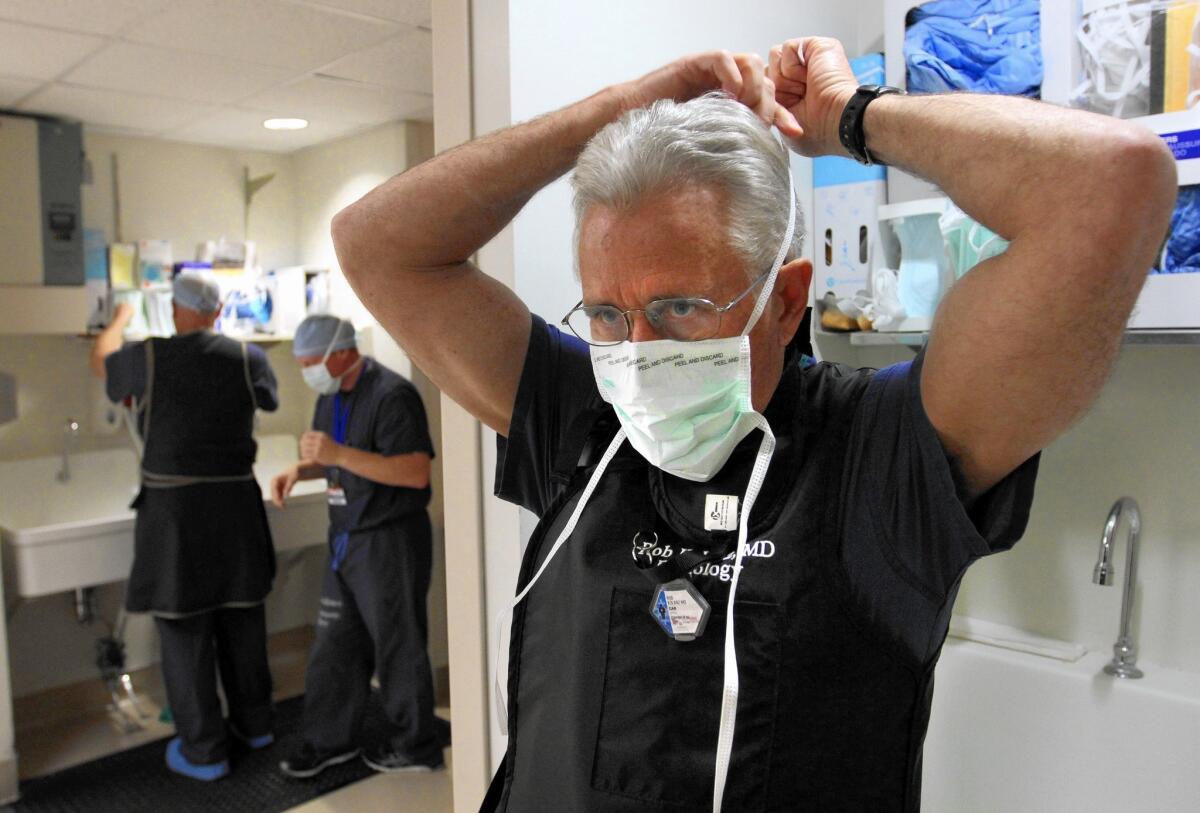How safe is your hospital? A look at California ratings

- Share via
Consumers might think twice about dining at a restaurant with a poor health grade posted in the window. And patient advocates say it shouldn’t be any different when going to the hospital.
A detailed look at performance data shows many California hospitals continue to struggle with medical errors and injuries to patients — despite industrywide efforts to remedy those problems.
“We know there are still far too many deaths due to medical errors and far too many patients harmed,” said Missy Danforth, senior director of hospital ratings at Leapfrog Group, an employer-backed nonprofit that tracks healthcare quality. “Not all hospitals are the same.”
Since 2012, Leapfrog has been analyzing information it collects as well as data reported to Medicare to issue hospital scores in California and nationwide. The percentage of A-rated hospitals in California reached 43% late last year — the seventh-highest rate among states nationwide. That was up from 40% two years ago.
Healthcare giant Kaiser Permanente consistently posts some of the highest scores and shows little variation across its 35 hospitals in California.
Other top performers across the Southland include Cedars-Sinai Medical Center, Hoag Memorial Hospital Presbyterian in Newport Beach and Inglewood’s Centinela Hospital Medical Center.
Overall, however, scores in California have shown no improvement in recent years. The Times reviewed three years of Leapfrog data, and the overall letter grade remained a solid B.
After converting letter grades to scores of 0 through 4, the statewide composite for 250 California hospitalswent from an average of 3.06 in fall 2012 to 3.04two years later.
Some of the laggards include UCLA Ronald Reagan Medical Center with a C letter grade. Los Angeles County-USC Medical Center got a D, partly because it was in the bottom 1% of hospitals nationwide for leaving objects like sponges in patients during surgery.
Maribeth Shannon, who tracks hospital quality at the California HealthCare Foundation, says the Leapfrog results are in line with what other publicly reported data show.
Medical centers are implementing safer practices, such as more rigorous hand washing, improved staffing and better use of antibiotics, she said, but those changes haven’t yielded significant progress on patient outcomes.
“The improvement is glacial,” said Shannon, director of the foundation’s market and policy monitor program. “This shows how hard these problems are to fix and how much culture change is needed in hospitals.”
In response to concerns about hospital safety,federal officials have been getting tougher on the industry by fining hospitals that have a higher incidence of infections or patients being readmitted.
Nationwide, medical experts say about 400,000 lives are lost annually to hospital errors. One in every 25 hospital patients will contract a new infection during their stay, according the U.S. Centers for Disease Control and Prevention.
Leapfrog’s semiannual report card is derived from a mixture of publicly reported data and results from its own survey. Some performance measures are risk-adjusted for patient severity and income so hospitals aren’t penalized for admitting sicker, poorer patients.
An interactive map of Leapfrog scores for 250 hospitals statewide can be found online in addition to other helpful hospital resources for consumers.
Large employers founded Leapfrog in 1998 as a way to work together on improving the quality and affordability of U.S. healthcare.
Some hospital industry officials have criticized Leapfrog’s letter grades as too simplistic for a complex issue and potentially misleading to patients.
“We support transparency,” said Dr. David Perrott, chief medical officer at the California Hospital Assn. “But you can’t look at one particular measurement from one organization and say that tells the true care at that hospital.”
Nonetheless, there have been frequent incidents at area hospitals that serve as reminders of what’s at stake for patients and their families.
In October, one of Orange County’s largest hospitals briefly halted elective surgeries after four patients were diagnosed with infections.
Mission Hospital said it resolved the issues at both its Mission Viejo and Laguna Beach locations. “We will always take the necessary actions to provide the highest level of safe, quality care to our patients,” the hospital said.
In November, the state medical board disciplined a surgeon for removing the wrong kidney from a patient at St. Jude Medical Center in Fullerton in 2012. Separately, California regulators fined the hospital $100,000 in 2013 for the incident.
As a result of the error, St. Jude said, it put “stringent safeguards in place” to ensure protocols are followed. For instance, a surgery cannot be scheduled until patient records and images are submitted in advance, and the information must be reviewed “as part of the safety check.”
Leapfrog said Los Angeles County-USC Medical Center was below the national average for post-operative blood clots, foreign objects being left behind in patients and several other measures of care.
Dr. Brad Spellberg, the hospital’s chief medical officer, said the county recognized it had deficiencies and it has “turbocharged” its quality program to address them.
For instance, he noted, the hospital purchased a system that uses radio-frequency tags in sponges and gauze and alerts doctors and nurses about an object left behind when they wave a wand over the patient’s body.
“Retained foreign objects was a clear red flag, and we took action to fix it,” Spellberg said. He said the hospital hasn’t had any incidents of foreign objects left behind in the last six months.
“We all want consumers to be satisfied with the care they receive. We aren’t making excuses,” he added.
Providence Health & Services, which runs six hospitals in Southern California, illustrates the variation in scores within larger hospital systems.
Two of its area hospitals, Providence Little Company of Mary Medical Center in Torrance and Saint John’s Health Center in Santa Monica, earned A grades for patient safety. But its four other facilities in Southern California, including Providence St. Joseph Medical Center of Burbank, received C grades, according to Leapfrog.
Dr. Lanny Eason, Providence’s chief medical officer in Southern California, said the industry must be more forthcoming with the public about a hospital’s strengths and weaknesses.
“The days of hiding mistakes are over,” Eason said. “We all need to be accountable for the work we are doing. We are in the business of healing, not harming.”
At Providence, Eason said, there’s a concerted effort to share data and best practices across hospitals through regular meetings among doctors, pharmacists and nurses. Those efforts have helped Providence reduce elective early deliveries that pose a higher risk of complications and cut the number of bloodstream infections, he said.
At times, large public hospitals complain that they are discriminated against in these scores because they treat the most complicated patients with multiple chronic conditions and the data don’t always reflect that.
But UC medical centers have largely shined in the Leapfrog ratings — except for UCLA Ronald Reagan Medical Center. It has a C letter grade, up from an F in 2012.
Seven other UC medical centers, including UCLA’s Santa Monica hospital, notched top grades.
Dr. Robert Cherry, chief medical and quality officer at UCLA Health System, said the university “takes the Leapfrog survey seriously and strives to provide exceptional care to all our patients. We are continually working to find ways to improve.”
The Obama administration has credited the hospital industry with some recent advances. Federal officials estimate that during 2010 to 2013, 1.3 million fewer patients were harmed in U.S. hospitals than expected. That represented a 17% decline.
Consumer advocates urge patients to check a variety of sources when choosing a hospital — in addition to consulting with their doctor.
Medicare’s Hospital Compare website at https://www.medicare.gov/hospitalcompare offers valuable information. There’s also data available from the California HealthCare Foundation’s https://www.calqualitycare.org on a wide range of medical providers and at Consumer Reports’ Safe Patient Project at safepatientproject.org/tags/consumer_reports.
Leapfrog’s Danforth said the advent of bigger insurance deductibles has led many people to become savvier shoppers and more accustomed to checking costs online. She said consumers should do the same legwork on safety.
“A lot of people think the most expensive healthcare is the best healthcare. That is not the case at all,” she said. “In some communities the cheapest hospital is the safest.”
Twitter: @chadterhune, @LATdoug
More to Read
Inside the business of entertainment
The Wide Shot brings you news, analysis and insights on everything from streaming wars to production — and what it all means for the future.
You may occasionally receive promotional content from the Los Angeles Times.












